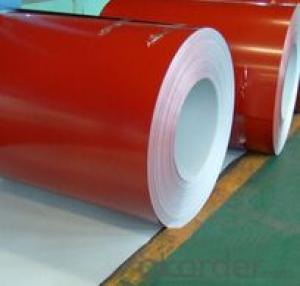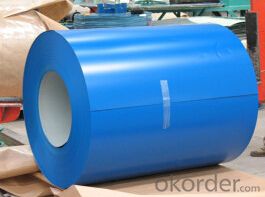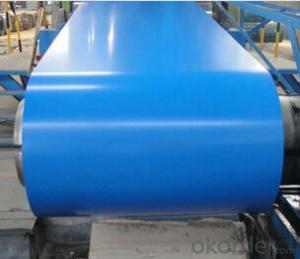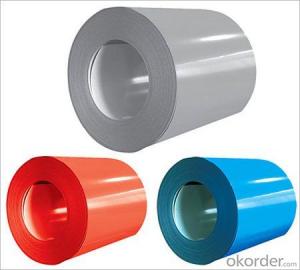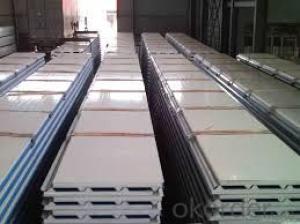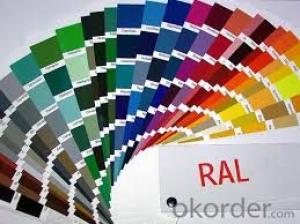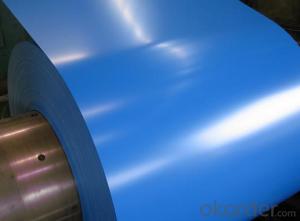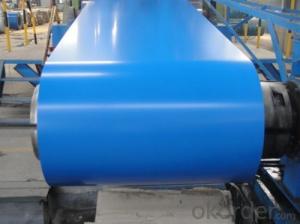PPGL/Color Steel Coil/Prepainted Galvanized Steel Coil
- Loading Port:
- Tianjin
- Payment Terms:
- TT OR LC
- Min Order Qty:
- 25 m.t.
- Supply Capability:
- 10000 m.t./month
OKorder Service Pledge
OKorder Financial Service
You Might Also Like
Description:
Model NO.:ASTM, JIS, GB, AISI, DIN, BS
Surface Treatment:Alu-Zin Coating
Certification:ISO, SGS, BV, RoHS, IBR
Technique:Hot Rolled
Standard:ASTM, JIS, GB, AISI, DIN, BS
Application:Roof Building Construction
Edge:Slit edge
Stock:Stock
Steel Grade:Q235
Thickness:0.16-0.8mm
Width:914/1000/1200/1219/1220/1250mm
Al-Zinc Coating:Az50-150G/M2
Spangle:Regular Spangle
Surface Printing:Can Be Used The Base Material of PPGL
Export Markets:Global
Additional Info.
Packing:Export High-Accuracy Package
Standard:0.45*1219*C
Origin:China
HS Code:72104900
Production Capacity:30000mt
Product Description
Specification :
1. Thickness: 0.12mm-1.3mm
2. Width: 600mm-1250mm
3. Length: According to client's demands
4. Top paint: 15 to 25 um (5 um + 12-20 um)
Back paint: 7 +/- 2 um5. Gloss: Normal or High gloss
6. Alume Zinc coating: AZ50-AZ275G/psm
7. Inside Diameter: 508mm/610mm
8. Outside Diameter: 1000mm-1500mm
9. Coil weight: 3-8 tons
10. Payment: T/T, L/C, D/P, Paypal, Western Union
11. Trade Term: FOB, CFR, CIF
12. MOQ: 25 Mt
13. Package: Export standard package or as request
14. Shipment: By container
15. Standard: AISI, ASTM, BS, DIN, GB, JIS
16. Grade: JIS G3322, CGLCC, ASTM A755, CS-B
| Commodity | Hot Dip Alu-zinc Steel Coils |
| Techinical Standard: | ASTM A792 |
| Grade | TDX51D+AZ, SGLCC |
| Types: | Commercial / Drawing / Deep Drawing / Structural quality |
| Thickness | 0.18-1.0mm |
| Width | 914/1000/1200/1219/1220/1250mm |
| Type of coating: | galvalume (AL-zinc) |
| Zinc coating | AZ50-150g/m2 |
| Surface treament | chromed with passivation / environmental chromed |
| oiled/slightly oiled/ dry/not anti-fingerprint/ skinpassed | |
| Zincalume with protection film (35 µ , Nominal Adhesion 265 gr/ 50mm) | |
| Based metal: Steel Sheet, 55% Aluminum-Zinc alloy coated in Coils | |
| ID coil | 508mm or 610mm |
| MIQ | minimum 25 MT for each size |
| Supply capacity: | 1000MT per month |
| Package: | Properly packed for ocean freight exportation in containers |
| Application: | Industrial panels, roofing and siding for painting |
| Price terms | FOB, CFR, CIF |
| Payment terms | 20%TT in advance+80% TT or irrevocable 80%L/C at sight |
| delivery time | 25 days after recepit of 20% TT |
| Remarks | Insurance is all risks |
| MTC 3.1 will be handed on with shipping documents | |
| We accept SGS certificatation test | |
FAQ
1.What's your MOQ?
25MT, it is for one container.
2.Do you have QC teams?
Yeah, sure, our QC team is very important, they will keep the quality control for our products.
3. What's your normal delivery time?
Our delivery time about 10-20days for standard sizes, if you have other requirements like hardness and width ,it is about 20-40days. But don't worry ,we also try our best for the delivery time ,because time longer and our cost is higher.
4.Are the products tested before shipping?
Yes, all of our PPGI and GI was qualified before shipping. We test every batch every day
- Q: What is the difference between regular steel stainless steel? Why does steel rust but stainless wont? Is stainless some kind of alloy or something? Any knowledgeable input would be great. Thanx!
- the reagent of choice is toluene-3,4-dithiol.
- Q: Ok, I have motorcycle classes and im afraid that I wont feel the gear shifter when shifting. So I want to make the boot softer from the toes where the steel is at so i can feel the gear shift with my toes. When i walk and bump into something by accident with my boots I dont feel anything I almost dont notice it. So I think i will be a problem since I wont be able to feel anything.
- You're not from this world, are you?
- Q: How are steel coils labeled for identification?
- Steel coils are typically labeled for identification using stickers or tags that contain information such as the coil number, dimensions, weight, grade, and other relevant details.
- Q: How are steel coils processed and shaped into various products?
- Steel coils are processed and shaped into various products through a series of manufacturing processes. First, the steel coil is uncoiled and cleaned to remove any impurities. Then, it goes through a process called leveling, where the coil is flattened and straightened. Next, the steel is cut into the desired length or shape, using techniques like shearing or slitting. After that, it may undergo additional processes such as forming, bending, or rolling to give it the desired shape. Finally, the steel is often treated with coatings or finishes to enhance its durability and appearance.
- Q: I have a knife with AUS8 Stainless Steel. No idea what that means. I want to know some of the best stainless steels for knifes and all you can tell me about stainless steel would be great. I was browsing google and looking at grades and had no idea what all the numbers meant. Thanks!
- The two main ingredients in knife steel are carbon and chromium with some extras that have varying effects on hardness and toughness. Aus8 is similar to 440A stainless with less chromium which would make it a little stronger. I've tested aus8 blades and wasn't real impressed with its edge holding compared to even 5160 carbon steel (the lowest grade I use).
- Q: What are the common welding techniques used for steel coils?
- The common welding techniques used for steel coils include shielded metal arc welding (SMAW), gas metal arc welding (GMAW), and flux-cored arc welding (FCAW). SMAW, also known as stick welding, is a manual welding process where an electric current is used to create an arc between the welding electrode and the base material. The electrode is coated with a flux material that provides a shielding gas to protect the weld from atmospheric contamination. This technique is versatile and can be used for both thick and thin steel coils. GMAW, commonly referred to as MIG (metal inert gas) welding, is an automated process that uses a continuous wire electrode and a shielding gas to protect the weld area. The electrode is fed through a welding gun, and an electric current creates an arc between the wire and the base material. This technique is fast and efficient, making it suitable for high-volume production of steel coils. FCAW is a variation of GMAW that uses a tubular electrode filled with flux instead of a solid wire. The flux provides a shielding gas and also releases additional fluxing agents to protect the weld from impurities. FCAW is often preferred for welding thicker steel coils as it provides better penetration and higher deposition rates. In addition to these techniques, other welding methods like laser welding and electron beam welding can also be used for specific applications in steel coil manufacturing. These techniques offer precise and high-quality welds but are typically more expensive and require specialized equipment. Overall, the choice of welding technique for steel coils depends on factors such as the thickness of the material, production volume, and specific requirements of the end product.
- Q: the comparison needed between other steel
- It's cheaper than alloyed steels.
- Q: What are the common methods of inspecting steel coils for defects?
- There are several common methods used for inspecting steel coils for defects. These methods include visual inspection, ultrasonic testing, magnetic particle inspection, and eddy current testing. Visual inspection is the most basic method and involves physically examining the surface of the steel coil for any visible defects such as cracks, dents, or surface irregularities. This method is usually the first step in the inspection process and can quickly identify any obvious defects. Ultrasonic testing is a more advanced method that uses high-frequency sound waves to detect defects within the steel coil. A probe is used to transmit ultrasonic waves into the coil, and any internal flaws or defects will reflect the sound waves back to the probe. This method is effective for detecting defects such as voids, cracks, or inclusions within the material. Magnetic particle inspection is another commonly used method for inspecting steel coils. This technique involves magnetizing the coil and then applying iron particles to the surface. Any defects or cracks will cause a disturbance in the magnetic field, attracting the iron particles and making them visible. This method is particularly effective for detecting surface cracks or defects. Eddy current testing is a non-destructive method that uses electromagnetic induction to detect defects in the steel coil. A probe is used to generate an alternating magnetic field, and any changes in the electrical conductivity or magnetic permeability of the material due to defects will produce eddy currents. These eddy currents can be measured and analyzed to identify defects such as cracks, voids, or changes in material properties. Overall, these common methods of inspecting steel coils for defects provide various levels of accuracy and sensitivity, allowing for thorough inspections to ensure the quality and integrity of the steel coils. The choice of method depends on factors such as the type and size of defects to be detected, the required level of inspection accuracy, and the cost and time constraints of the inspection process.
- Q: What are the different types of corrosion protection for steel coils?
- There are several different types of corrosion protection for steel coils, including galvanizing, paint coatings, organic coatings, and metallic coatings. Each method provides a barrier between the steel surface and the corrosive environment, preventing or slowing down the corrosion process. Galvanizing involves applying a layer of zinc to the steel surface, while paint coatings use various types of paints or primers. Organic coatings utilize polymers or resins to form a protective layer, and metallic coatings such as tin or aluminum can also be applied. The choice of corrosion protection method depends on factors such as the specific corrosive environment, desired lifespan, and cost considerations.
- Q: What are the weight ranges of steel coils?
- The weight ranges of steel coils can vary widely depending on the specific type and dimensions of the coil. However, typical weight ranges for steel coils can range from a few hundred kilograms to several tons.
Send your message to us
PPGL/Color Steel Coil/Prepainted Galvanized Steel Coil
- Loading Port:
- Tianjin
- Payment Terms:
- TT OR LC
- Min Order Qty:
- 25 m.t.
- Supply Capability:
- 10000 m.t./month
OKorder Service Pledge
OKorder Financial Service
Similar products
Hot products
Hot Searches
Related keywords
